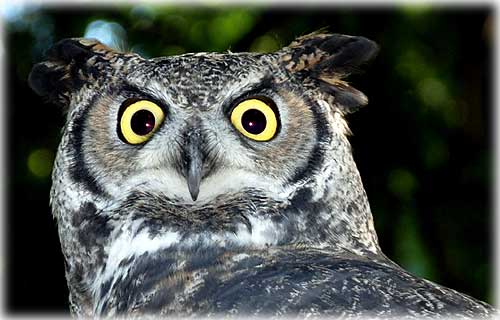 May 16, 2007
According to Danika Fornear Bird Curator at the Center, Moonie is definitely favored amongst both staff and visitors due to his striking looks and gentle disposition. She said he is a true "feathered ambassador", allowing the Center's visitors an up close and personal view of these magnificent birds. Fornear said, "He is even trained to flap his wings during presentations to illustrate 'silent flight', where owls make no noise when flying so they can sneak up on their prey."  Photo courtesy Deer Mountain Tribal Hatchery & Eagle Center Photograph by Karla Hayward
The great horned owl preys mostly on small mammals, although they will also hunt birds and reptiles, as well. One of their favorite prey items is skunk! Like most birds, great horned owls have a poor sense of smell, so getting sprayed by a skunk won't bother them a bit. In fact, if they do get sprayed, it's an advantage for the owl because if he smells bad it keeps other animals away from him, so someone doesn't try to steal his kill, or even worse, try to eat him! Ketchikan Indian Community's Deer Mountain Tribal Hatchery and Eagle Center located in Ketchikan is currently home to thousands of salmon and trout and 12 awesome birds: two Harris Hawks, two Red-tailed Hawks, three Bald Eagles, a Golden Eagle, a Peregrine Falcon, a Turkey Vulture, and two Great Horned Owls. These 12 creatures have one thing in common, they have all been injured to the point that they cannot be returned to the wild because they would not survive on their own. Certain death faces an injured bird unable to survive on its own in the wild. If it were not for facilities like Ketchikan Indian Community's Non-Profit Eagle Center, many, many magnificent birds would not be alive today. The Eagle Center is located at 1158 Salmon Road in Ketchikan, Alaska. Live bird shows are presented daily and can be scheduled in advance. Bird Curator Danika Fornear said the shows can even be brought to you. For more information call (907) 228 5533 for more information on the Deer Mountain Tribal Hatchery & Eagle Center's live bird shows, the adopt-a-raptor program, hatchday parties, becoming a "Friend of the Eagle Center" Member, and other environmental education events.
Publish A Letter on SitNews Read Letters/Opinions
|